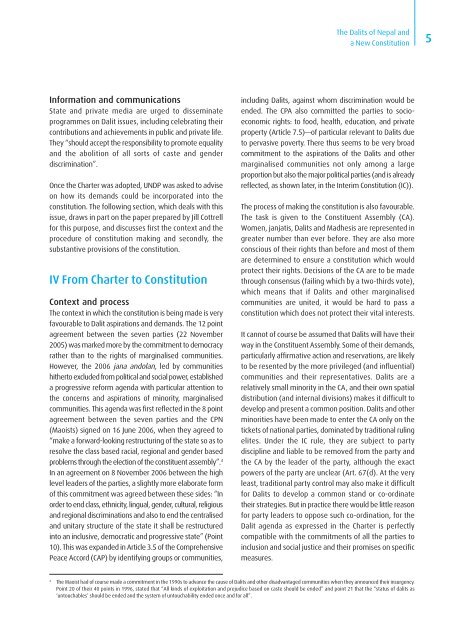The Dalits of Nepal and a New Constitution - ConstitutionNet
The Dalits of Nepal and a New Constitution - ConstitutionNet
The Dalits of Nepal and a New Constitution - ConstitutionNet
You also want an ePaper? Increase the reach of your titles
YUMPU automatically turns print PDFs into web optimized ePapers that Google loves.
<strong>The</strong> <strong>Dalits</strong> <strong>of</strong> <strong>Nepal</strong> <strong>and</strong><br />
a <strong>New</strong> <strong>Constitution</strong><br />
5<br />
Information <strong>and</strong> communications<br />
State <strong>and</strong> private media are urged to disseminate<br />
programmes on Dalit issues, including celebrating their<br />
contributions <strong>and</strong> achievements in public <strong>and</strong> private life.<br />
<strong>The</strong>y “should accept the responsibility to promote equality<br />
<strong>and</strong> the abolition <strong>of</strong> all sorts <strong>of</strong> caste <strong>and</strong> gender<br />
discrimination”.<br />
Once the Charter was adopted, UNDP was asked to advise<br />
on how its dem<strong>and</strong>s could be incorporated into the<br />
constitution. <strong>The</strong> following section, which deals with this<br />
issue, draws in part on the paper prepared by Jill Cottrell<br />
for this purpose, <strong>and</strong> discusses first the context <strong>and</strong> the<br />
procedure <strong>of</strong> constitution making <strong>and</strong> secondly, the<br />
substantive provisions <strong>of</strong> the constitution.<br />
IV From Charter to <strong>Constitution</strong><br />
Context <strong>and</strong> process<br />
<strong>The</strong> context in which the constitution is being made is very<br />
favourable to Dalit aspirations <strong>and</strong> dem<strong>and</strong>s. <strong>The</strong> 12 point<br />
agreement between the seven parties (22 November<br />
2005) was marked more by the commitment to democracy<br />
rather than to the rights <strong>of</strong> marginalised communities.<br />
However, the 2006 jana <strong>and</strong>olan, led by communities<br />
hitherto excluded from political <strong>and</strong> social power, established<br />
a progressive reform agenda with particular attention to<br />
the concerns <strong>and</strong> aspirations <strong>of</strong> minority, marginalised<br />
communities. This agenda was first reflected in the 8 point<br />
agreement between the seven parties <strong>and</strong> the CPN<br />
(Maoists) signed on 16 June 2006, when they agreed to<br />
“make a forward-looking restructuring <strong>of</strong> the state so as to<br />
resolve the class based racial, regional <strong>and</strong> gender based<br />
problems through the election <strong>of</strong> the constituent assembly”. 4<br />
In an agreement on 8 November 2006 between the high<br />
level leaders <strong>of</strong> the parties, a slightly more elaborate form<br />
<strong>of</strong> this commitment was agreed between these sides: “In<br />
order to end class, ethnicity, lingual, gender, cultural, religious<br />
<strong>and</strong> regional discriminations <strong>and</strong> also to end the centralised<br />
<strong>and</strong> unitary structure <strong>of</strong> the state it shall be restructured<br />
into an inclusive, democratic <strong>and</strong> progressive state” (Point<br />
10). This was exp<strong>and</strong>ed in Article 3.5 <strong>of</strong> the Comprehensive<br />
Peace Accord (CAP) by identifying groups or communities,<br />
including <strong>Dalits</strong>, against whom discrimination would be<br />
ended. <strong>The</strong> CPA also committed the parties to socioeconomic<br />
rights: to food, health, education, <strong>and</strong> private<br />
property (Article 7.5)—<strong>of</strong> particular relevant to <strong>Dalits</strong> due<br />
to pervasive poverty. <strong>The</strong>re thus seems to be very broad<br />
commitment to the aspirations <strong>of</strong> the <strong>Dalits</strong> <strong>and</strong> other<br />
marginalised communities not only among a large<br />
proportion but also the major political parties (<strong>and</strong> is already<br />
reflected, as shown later, in the Interim <strong>Constitution</strong> (IC)).<br />
<strong>The</strong> process <strong>of</strong> making the constitution is also favourable.<br />
<strong>The</strong> task is given to the Constituent Assembly (CA).<br />
Women, janjatis, <strong>Dalits</strong> <strong>and</strong> Madhesis are represented in<br />
greater number than ever before. <strong>The</strong>y are also more<br />
conscious <strong>of</strong> their rights than before <strong>and</strong> most <strong>of</strong> them<br />
are determined to ensure a constitution which would<br />
protect their rights. Decisions <strong>of</strong> the CA are to be made<br />
through consensus (failing which by a two-thirds vote),<br />
which means that if <strong>Dalits</strong> <strong>and</strong> other marginalised<br />
communities are united, it would be hard to pass a<br />
constitution which does not protect their vital interests.<br />
It cannot <strong>of</strong> course be assumed that <strong>Dalits</strong> will have their<br />
way in the Constituent Assembly. Some <strong>of</strong> their dem<strong>and</strong>s,<br />
particularly affirmative action <strong>and</strong> reservations, are likely<br />
to be resented by the more privileged (<strong>and</strong> influential)<br />
communities <strong>and</strong> their representatives. <strong>Dalits</strong> are a<br />
relatively small minority in the CA, <strong>and</strong> their own spatial<br />
distribution (<strong>and</strong> internal divisions) makes it difficult to<br />
develop <strong>and</strong> present a common position. <strong>Dalits</strong> <strong>and</strong> other<br />
minorities have been made to enter the CA only on the<br />
tickets <strong>of</strong> national parties, dominated by traditional ruling<br />
elites. Under the IC rule, they are subject to party<br />
discipline <strong>and</strong> liable to be removed from the party <strong>and</strong><br />
the CA by the leader <strong>of</strong> the party, although the exact<br />
powers <strong>of</strong> the party are unclear (Art. 67(d). At the very<br />
least, traditional party control may also make it difficult<br />
for <strong>Dalits</strong> to develop a common st<strong>and</strong> or co-ordinate<br />
their strategies. But in practice there would be little reason<br />
for party leaders to oppose such co-ordination, for the<br />
Dalit agenda as expressed in the Charter is perfectly<br />
compatible with the commitments <strong>of</strong> all the parties to<br />
inclusion <strong>and</strong> social justice <strong>and</strong> their promises on specific<br />
measures.<br />
4<br />
<strong>The</strong> Maoist had <strong>of</strong> course made a commitment in the 1990s to advance the cause <strong>of</strong> <strong>Dalits</strong> <strong>and</strong> other disadvantaged communities when they announced their insurgency.<br />
Point 20 <strong>of</strong> their 40 points in 1996, stated that “All kinds <strong>of</strong> exploitation <strong>and</strong> prejudice based on caste should be ended” <strong>and</strong> point 21 that the “status <strong>of</strong> dalits as<br />
‘untouchables’ should be ended <strong>and</strong> the system <strong>of</strong> untouchability ended once <strong>and</strong> for all”.








![g]k fnsf blntx? / gofF ;+l jwfg](https://img.yumpu.com/49483602/1/184x260/gk-fnsf-blntx-goff-l-jwfg.jpg?quality=85)



![+ljwfg;ef, /fHosf]k'g](https://img.yumpu.com/41604075/1/184x260/-ljwfgef-fhosfkg.jpg?quality=85)




